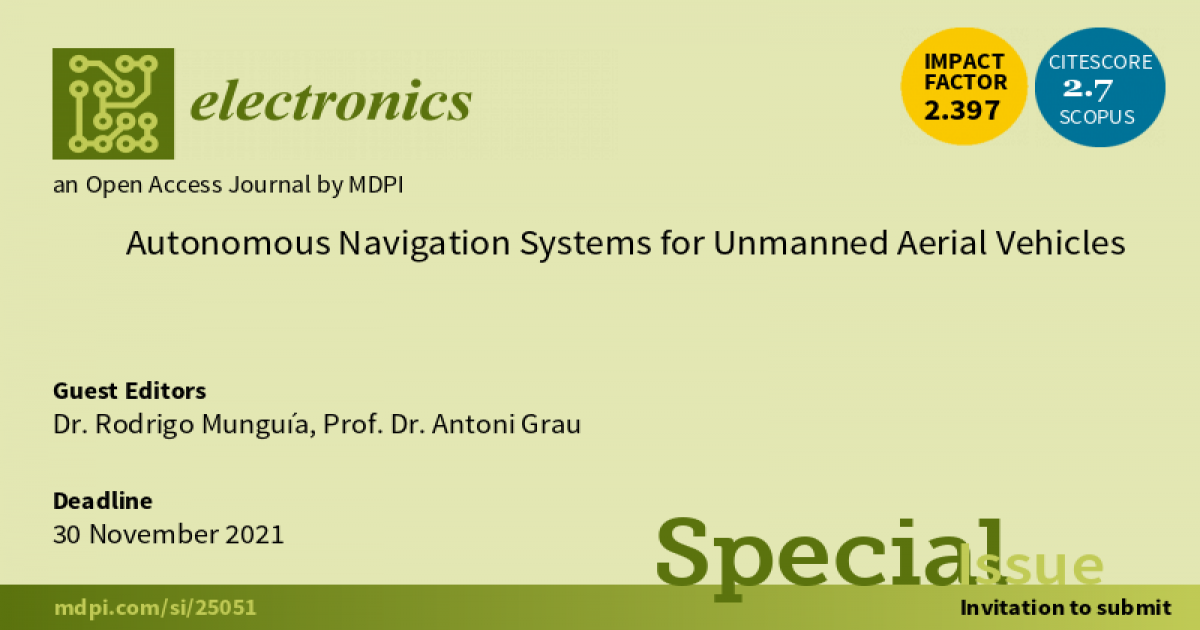Autonomous Navigation Systems for Unmanned Aerial Vehicles
A special issue of Electronics (ISSN 2079-9292). This special issue belongs to the section "Electrical and Autonomous Vehicles".
Deadline for manuscript submissions: closed (30 November 2021) | Viewed by 59741

Special Issue Editors
Interests: mobile robotics; unmanned aerial vehicles; navigation systems for autonomous vehicles; automatic control; optimal state estimation and computer vision
Interests: robotic control; system dynamics; industrial robots control and planning; autonomous robots; robot navigation; sensors in robotics
Special Issues, Collections and Topics in MDPI journals
Special Issue Information
Dear Colleagues,
Autonomous navigation is a fundamental necessity for any application involving unmanned aerial vehicles (UAV). The global positioning system (GPS) and inertial measurements units (IMU), or their fused variant, the inertial navigation systems (INS), represent the most common approaches for addressing the problem of UAVs navigation. Nevertheless, cluttered, and GPS-denied, environments still pose a considerable challenge. Moreover, GPS-based navigation can be unreliable in several scenarios where precision maneuvers are required. This Special Issue is intended to contribute to the research area of autonomous navigation systems for UAVs.
Also, to control and navigate, UAVs require the use of several critical on-board sensors that can generate data enough to perform those tasks. The reading, treatment, processing, and understanding of this data in real time is another open issue that will be covered by this Special Issue. Finally, depending on the UAV usage, specific sensors and actuators will be needed to carry out the operation of the UAV. With these specific sensors and actuators, UAV can be used for many real applications, not only to carry cameras and taking pictures or movies. The proposal and use of new actuators on-board is of great interest in the robotics community. In this Special Issue, papers dealing with these problems will be welcome.
In this Special Issue proposal, potential topics include but are not limited to the following:
- Simultaneous localization and mapping;
- Visual odometry and visual-based navigation;
- GPS-denied methods;
- Cooperative navigation;
- SCLAM (simultaneous control localization and mapping);
- Control and state estimation for UAVs;
- Trajectory tracking;
- Tracking of dynamic targets;
- 3D mapping;
- Sensory system for flight control;
- Sensors and actuators in UAV for applications.
Dr. Rodrigo Munguia
Dr. Antoni Grau
Guest Editors
Manuscript Submission Information
Manuscripts should be submitted online at www.mdpi.com by registering and logging in to this website. Once you are registered, click here to go to the submission form. Manuscripts can be submitted until the deadline. All submissions that pass pre-check are peer-reviewed. Accepted papers will be published continuously in the journal (as soon as accepted) and will be listed together on the special issue website. Research articles, review articles as well as short communications are invited. For planned papers, a title and short abstract (about 250 words) can be sent to the Editorial Office for assessment.
Submitted manuscripts should not have been published previously, nor be under consideration for publication elsewhere (except conference proceedings papers). All manuscripts are thoroughly refereed through a single-blind peer-review process. A guide for authors and other relevant information for submission of manuscripts is available on the Instructions for Authors page. Electronics is an international peer-reviewed open access semimonthly journal published by MDPI.
Please visit the Instructions for Authors page before submitting a manuscript. The Article Processing Charge (APC) for publication in this open access journal is 2400 CHF (Swiss Francs). Submitted papers should be well formatted and use good English. Authors may use MDPI's English editing service prior to publication or during author revisions.
Keywords
- Unmanned aerial vehicles
- Drone
- SLAM
- Robot navigation
- UAV control
- Tracking
- Visual odometry
- Mapping
- Sensors and actuators in UAV
Benefits of Publishing in a Special Issue
- Ease of navigation: Grouping papers by topic helps scholars navigate broad scope journals more efficiently.
- Greater discoverability: Special Issues support the reach and impact of scientific research. Articles in Special Issues are more discoverable and cited more frequently.
- Expansion of research network: Special Issues facilitate connections among authors, fostering scientific collaborations.
- External promotion: Articles in Special Issues are often promoted through the journal's social media, increasing their visibility.
- Reprint: MDPI Books provides the opportunity to republish successful Special Issues in book format, both online and in print.
Further information on MDPI's Special Issue policies can be found here.






